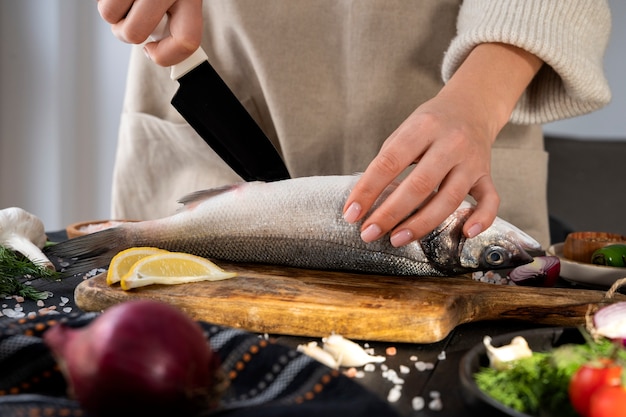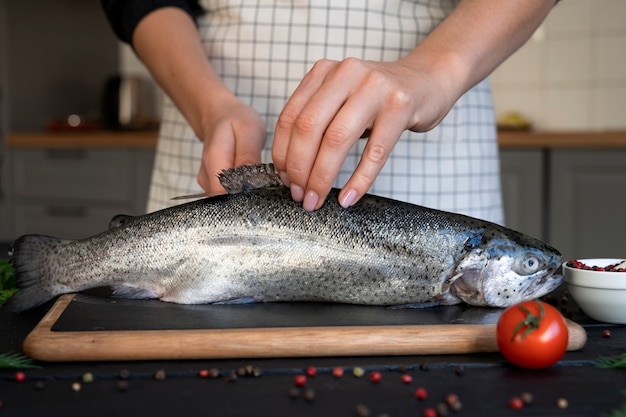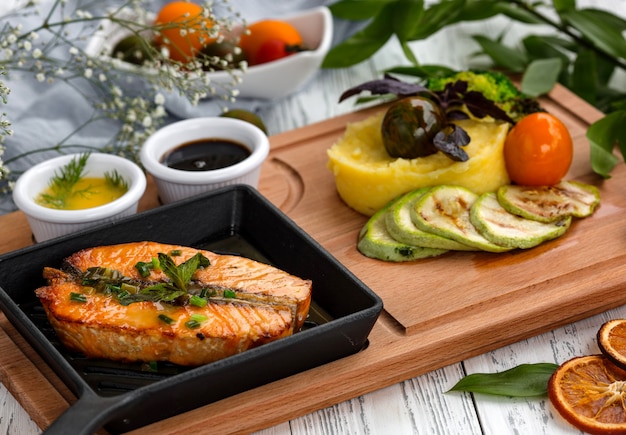Remember those nights when you're craving a light and healthy dinner, but the thought of cooking something elaborate just makes you want to curl up on the sofa? That's where oven-baked fish comes in! It's a true lifesaver, I tell you. It's ridiculously easy to prepare, yet it always tastes fantastic. And the best part? It's incredibly versatile. You can experiment with all sorts of different flavours and toppings, so you'll never get bored.
I've been a huge fan of oven-baked fish for years. It's my go-to recipe when I'm feeling tired after a long day at work, or when I want something quick and healthy to make for friends. Over the years, I've tried out countless different recipes and variations. I've learned a thing or two about what works and what doesn't.
This article is a collection of my favourite tips, tricks, and recipes for baking fish to perfection. I'm going to share everything I've learned with you, from choosing the right fish to getting that perfect crispy skin. Get ready to impress yourself and your loved ones with these simple yet delicious recipes. Let's dive in!
(Part 1) The best fish for oven baking

The first step to making a great oven-baked fish dish is choosing the right fish. Not all fish are created equal when it comes to oven baking. Some are more forgiving than others, and some have a texture that's better suited to this method.
Choosing the Right Fish
When choosing your fish, consider these factors:
- Type of fish: Some fish, like salmon and cod, have a naturally flaky texture that makes them perfect for oven baking. They cook quickly and hold their shape well, making them easy to handle. Other fish, like tuna and swordfish, can be a bit tougher and might require a different cooking method. For example, tuna is better suited for grilling or searing due to its dense, firm texture.
- Thickness: Thicker fillets will take longer to cook than thinner ones. If you're using thick fillets, you might need to adjust the cooking time accordingly. Remember, you want the fish to be cooked through, but not dry.
- Freshness: Always choose fresh fish, and if possible, ask your fishmonger for recommendations on the best types of fish for oven baking. They can often point you in the right direction, depending on the season and availability.
- Seasonality: Look for fish that are in season. You'll find that they taste better and are more affordable when they're in season. For instance, salmon is usually at its peak in the summer months, while cod is more readily available in the winter.
Popular Fish for Oven Baking
Here are some of the most popular fish for oven baking:
- Salmon: Salmon is a favourite for a reason! It's rich, fatty, and incredibly flavourful. It also cooks up beautifully in the oven, with a crispy skin and tender, flaky flesh. Salmon is a great source of omega-3 fatty acids, which are beneficial for heart health.
- Cod: Cod is a mild and versatile fish that works well in a variety of recipes. It's a good choice for beginners as it's quite forgiving and doesn't easily dry out.
- Halibut: Halibut is a firm, white fish with a slightly sweet flavour. It's a great option for grilling or baking, and it holds its shape well. Halibut is a lean protein source and is rich in vitamin D.
- Sea Bass: Sea bass has a delicate flavour and a firm texture. It's a great choice for baking whole or in fillets. Sea bass is a good source of protein and potassium.
- Haddock: Haddock is another popular choice for oven baking. It's a lean, white fish with a mild flavour. Haddock is a good source of protein and vitamin B12.
(Part 2) Preparing Your Fish for Baking

Once you've chosen your fish, it's time to prepare it for baking. This might seem straightforward, but there are a few tips and tricks that can make a big difference in the final result.
1. Cleaning and Patting Dry
Cleaning the fish is a crucial step. Rinse the fish under cold running water, removing any scales, gills, or internal organs. Pat the fish dry with paper towels. This helps to create a crispy skin and prevent the fish from steaming during cooking, which can make it soggy.
2. Scoring the Skin
Scoring the skin of the fish before baking helps to prevent it from curling up and to allow the fat to render out, creating a crispy texture. To score the fish, use a sharp knife to make diagonal cuts across the skin, about 1/4 inch deep.
3. Seasoning Your Fish
Seasoning your fish is where you can really get creative. There are endless possibilities, but here are a few basic seasonings that work well with most fish:
- Salt and Pepper: A classic combination that brings out the natural flavour of the fish. Use freshly ground pepper for the best flavour.
- Herbs: Fresh herbs like dill, parsley, thyme, and rosemary add a burst of flavour. For a more intense flavour, try using a combination of herbs, like dill and lemon zest, or thyme and garlic.
- Lemon: Lemon juice brightens up the flavour of the fish and adds a hint of acidity. A squeeze of fresh lemon juice over the finished dish is also a great way to add a final touch of flavour.
- Garlic: Garlic pairs beautifully with fish, adding a pungent and savory aroma. Use minced or crushed garlic for a more subtle flavour, or try roasted garlic for a sweeter, more mellow taste.
(Part 3) Oven-Baking Techniques

Now comes the fun part: baking your fish! This is where your creativity really shines. Here are some basic techniques to get you started.
1. Baking on a Sheet Pan
This is the simplest and most straightforward method. Preheat your oven to 400 degrees Fahrenheit. Place a piece of parchment paper on a baking sheet. Season your fish and place it on the parchment paper. Bake for 10-15 minutes, or until the fish is cooked through.
For a crispier skin, you can place the fish on a wire rack over the baking sheet. This allows heat to circulate around the fish, resulting in a more evenly cooked and crispy skin.
2. Baking in a Foil Packet
This method creates a moist and flavorful environment for your fish. Preheat your oven to 400 degrees Fahrenheit. Tear off a sheet of aluminum foil, large enough to fold over the fish. Place your seasoned fish on the foil. Add vegetables, herbs, or other seasonings to the packet. Fold the foil over the fish, creating a sealed packet. Bake for 15-20 minutes, or until the fish is cooked through.
This method is great for delicate fish that might dry out easily. The steam created in the foil packet helps to keep the fish moist and flavorful. You can also add a splash of white wine or broth to the packet for extra flavour.
3. Baking in a Baking Dish
This method is ideal for baking fish with a sauce or other toppings. Preheat your oven to 400 degrees Fahrenheit. Place a piece of parchment paper in a baking dish. Season your fish and place it in the baking dish. Add your sauce or toppings. Bake for 15-20 minutes, or until the fish is cooked through.
This method allows you to create a more complex dish, incorporating vegetables, herbs, or a flavorful sauce. For example, you could bake fish with a tomato-based sauce, a creamy lemon sauce, or a simple herb-infused butter sauce.
(Part 4) Fish Baking Times
The cooking time for your fish will depend on the type of fish you're using and the thickness of the fillets. Here's a general guide for baking times:
| Fish Type | Baking Time |
|---|---|
| Salmon (1-inch thick) | 12-15 minutes |
| Cod (1-inch thick) | 10-12 minutes |
| Halibut (1-inch thick) | 15-20 minutes |
| Sea Bass (1-inch thick) | 12-15 minutes |
| Haddock (1-inch thick) | 10-12 minutes |
These are just general guidelines. Always check the fish for doneness before removing it from the oven. The fish should be flaky and opaque, and the internal temperature should reach 145 degrees Fahrenheit. If you're unsure, err on the side of caution and cook it a little longer.
(Part 5) How to Know When Your Fish is Done
Knowing when your fish is cooked through is essential to ensure it's safe and delicious. Here are some ways to check for doneness:
1. The Flake Test
Gently press the fish with a fork. If the flesh flakes easily, it's cooked. The fish should flake apart without much resistance.
2. The Opaque Test
The fish should turn opaque (white or light-colored) when it's cooked. The flesh will become firmer and less translucent.
3. The Internal Temperature Test
Use a meat thermometer to check the internal temperature of the thickest part of the fish. It should reach 145 degrees Fahrenheit. This is the most accurate way to ensure the fish is cooked through.
(Part 6) Delicious Oven-Baked Fish Recipes
Now that you've got the basics down, let's dive into some delicious oven-baked fish recipes!
1. Simple Lemon and Herb baked salmon
This recipe is a classic for a reason. It's simple, flavorful, and perfect for a weeknight dinner.
- Ingredients:
- 1 pound salmon fillet (skin on)
- 1 tablespoon olive oil
- 1 lemon, thinly sliced
- 2 tablespoons fresh herbs (dill, parsley, or thyme)
- Salt and pepper to taste
- Instructions:
- Preheat oven to 400 degrees Fahrenheit.
- Place salmon fillet on a baking sheet lined with parchment paper, skin side down.
- Drizzle with olive oil and season with salt and pepper.
- Top with lemon slices and fresh herbs. You can use a combination of herbs like dill and parsley, or thyme and rosemary.
- Bake for 12-15 minutes, or until the salmon is cooked through. The internal temperature should reach 145 degrees Fahrenheit.
For a twist, try adding a drizzle of honey to the salmon before baking. The honey will caramelize in the oven, adding a touch of sweetness to the dish.
2. Mediterranean baked cod with Tomatoes and Olives
This recipe is full of flavour and packed with Mediterranean goodness.
- Ingredients:
- 1 pound cod fillets
- 1 tablespoon olive oil
- 1/2 cup chopped tomatoes (fresh or canned)
- 1/4 cup chopped olives (black or green)
- 1 tablespoon fresh oregano
- Salt and pepper to taste
- Instructions:
- Preheat oven to 400 degrees Fahrenheit.
- Place cod fillets on a baking sheet lined with parchment paper.
- Drizzle with olive oil and season with salt and pepper.
- Top with tomatoes, olives, and oregano.
- Bake for 10-12 minutes, or until the cod is cooked through.
This recipe is also great with other Mediterranean flavours, such as capers, artichoke hearts, or red pepper flakes. You can also add a squeeze of lemon juice for a bright and tangy touch.
3. Spicy Garlic and Chili Baked Halibut
This recipe is a great way to add a kick to your fish. It's quick, easy, and oh-so-delicious!
- Ingredients:
- 1 pound halibut fillets
- 1 tablespoon olive oil
- 2 cloves garlic, minced
- 1 teaspoon chili flakes (adjust to your heat preference)
- Salt and pepper to taste
- Instructions:
- Preheat oven to 400 degrees Fahrenheit.
- Place halibut fillets on a baking sheet lined with parchment paper.
- Drizzle with olive oil and season with salt and pepper.
- Top with minced garlic and chili flakes. For a milder heat, you can use less chili flakes.
- Bake for 15-20 minutes, or until the halibut is cooked through.
For a more intense flavour, you can marinate the halibut in a mixture of olive oil, garlic, chili flakes, and lemon juice for 30 minutes before baking. This will allow the flavours to penetrate the fish and create a more flavorful dish.
(Part 7) Tips for Baking Fish to Perfection
Here are some tips and tricks to help you bake the perfect fish every time:
- Don't overcook your fish: Fish cooks quickly, so it's important not to overcook it. Overcooked fish will be dry and tough.
- Use a baking sheet lined with parchment paper: This will prevent the fish from sticking and make cleanup a breeze.
- Don't overcrowd the baking sheet: Give your fish some space to breathe in the oven. If the fish is too crowded, it won't cook evenly.
- Use a meat thermometer: The best way to know if your fish is cooked through is to use a meat thermometer. It should reach 145 degrees Fahrenheit.
- Don't be afraid to experiment: Oven-baked fish is incredibly versatile. Try different seasonings, herbs, and vegetables to create your own unique flavour combinations. Experiment with different citrus fruits, like orange or grapefruit, or try adding a touch of ginger or soy sauce for an Asian-inspired flavour.
(Part 8) Serving Your Oven-Baked Fish
Once your fish is cooked, it's time to serve it up! Here are some ideas:
- Serve with a side of vegetables: Roasted vegetables, sauteed greens, or a simple salad make a healthy and delicious pairing with oven-baked fish. For a flavourful side dish, try roasting asparagus, broccoli, or Brussels sprouts with a drizzle of olive oil, salt, and pepper.
- Top with a sauce: A simple lemon butter sauce or a creamy herb sauce can elevate the flavour of your fish. For a quick and easy sauce, melt butter in a saucepan, add lemon juice, and whisk until smooth. You can also add fresh herbs, garlic, or a pinch of salt and pepper to the sauce.
- Serve over rice or pasta: Oven-baked fish can be served over a bed of rice or pasta for a more substantial meal. Try serving your fish over brown rice, quinoa, or a bed of pasta tossed in a simple pesto sauce.
- Make a fish taco: Break up the cooked fish and serve it in tortillas with your favourite toppings for a fun and flavourful meal. Add your favourite toppings, such as shredded cabbage, pico de gallo, avocado, or sour cream.
(Part 9) FAQs
Here are some frequently asked questions about oven-baked fish:
1. Can I bake frozen fish?
Yes, you can bake frozen fish, but it will need to be thawed first. To thaw fish quickly, place it in a bowl of cold water, changing the water every 30 minutes. You can also thaw fish in the refrigerator overnight. However, it's important to note that frozen fish may not have the same texture and flavour as fresh fish.
2. How do I know if my fish is fresh?
Fresh fish should have clear, bright eyes, firm flesh, and a mild, fresh smell. Avoid fish that has a strong fishy smell, cloudy eyes, or flesh that is mushy or discolored. If you're unsure, ask your fishmonger for advice.
3. What are some healthy side dishes to serve with oven-baked fish?
Roasted vegetables, sauteed greens, quinoa, brown rice, and salads are all healthy and delicious side dishes to serve with oven-baked fish. For a low-carb option, try serving your fish with a salad of mixed greens, tomatoes, cucumbers, and a light vinaigrette.
4. How can I prevent my fish from drying out?
Don't overcook your fish. Use a meat thermometer to check the internal temperature. You can also bake the fish in a foil packet or use a sauce or other topping to help keep the fish moist. Baking the fish with a little bit of liquid, like a splash of white wine or broth, can also help to keep it moist.
5. What if my fish sticks to the baking sheet?
Line your baking sheet with parchment paper to prevent sticking. You can also grease the baking sheet with cooking spray or oil. If your fish does stick, carefully loosen it with a spatula.
I hope this guide has been helpful. Happy baking!
Everyone is watching

How to Cook Frozen Lobster Tails Perfectly: A Step-by-Step Guide
RecipesLobster. Just the word conjures up images of lavish meals, special occasions, and a taste of luxury. But let's...

Pigs in a Blanket Cooking Time: How Long to Bake for Perfect Results
RecipesAh, pigs in a blanket. Just the name conjures up images of those delightful little parcels of crispy pastry en...

Pork Fillet Cooking Time: How Long to Cook It Perfectly
RecipesPork fillet, or tenderloin as it's sometimes called, is a real favourite in our house. It's so versatile, and...

The Ultimate Guide to Cooking Delicious Frankfurters
RecipesLet's face it, we all love a good frankfurter. It's a classic, simple, and always satisfying. But let's be rea...

Wolf Meat Recipes: A Guide to Cooking Wild Game
RecipesLet's be honest, you don't see wolf meat at your local butcher shop every day. It's a bit of a wild card, but ...
